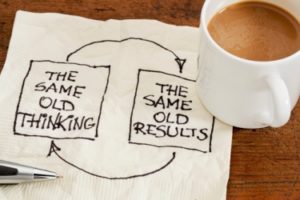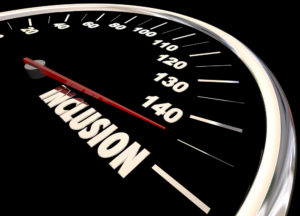Guest Blog by Gary Frank PhD, a colleague of many years that I continuously learn from with every cup of coffee or glass of wine.
Pamela’s most recent blog, discussed engagement as a key lever for enhancing an organization’s capability. In her example, engagement resulted in:
- Deeper understanding of the problem that needed to be solved.
- Identification and mitigation of organizational impediments.
- Bold solutions beyond what the leader would have dared.
- Greater speed and responsiveness.
Shifting Mindsets
Engagement that leads to these kinds of outcomes requires leaders to let go of prevailing assumptions and lean into new behaviors. Here are four assumptions that must shift.
1. Relinquishing absolute control
This may well be the shift that presents the biggest impediment to building change capability. Many leaders I have known have a strong orientation to control, believing it is the reason for their success. Engaging others runs counter to their notion of what constitutes strong, effective leadership.
Inviting members of the organization to co-create change requires leaders give them the authority and latitude required to do what they have been asked to do. We’ve all heard adages about the fox in the hen house and inmates running the jail. That’s not what this is about. Engagement is not leadership abdication. It’s leading in a different way. It means building employee capability to participate effectively and setting parameters for their participation.
Leading through engagement requires that leaders set clear objectives, establish appropriate scope and boundaries, plainly delineate the responsibility and authority of the team, and describe specific, clear deliverables.
2. Investment in people
When people in organizations haven’t previously been asked to participate genuinely, they don’t always possess the right skills for doing so. Engagement requires building capability consistent with what people are being asked to do.
There are some skill sets that are fundamental to engagement. One is how to participate effectively in teams. Sounds simple but think about how many dreadful team meetings you’ve sat through led by people who should know better. Other skills are related to what a team is being asked to do, e.g. data collection and analysis, process mapping, benchmarking. If you want to engage people fully, then you will have to invest in building their ability to do so. And once you build capability, it grows. People help others to learn what they’ve learned and a tipping point results.
3. Patience
In a world where organizational performance is measured one quarter at a time, patience is in short supply. However, engagement requires learning, and proficiency comes only with practice and experience. Allowing learning time requires your patience.
Being patient can be painful. We’ve all watched in anxious discomfort as something we could have done quickly stretches out over what seems like eternity. However, when ability becomes proficiency, the payoff is huge, and it keeps paying dividends.
4. Rethinking power
The fourth essential shift is re-framing power. If you frame power as a zero-sum game – that is, if someone else has some then you have less – then you will be averse to using engagement as a change strategy. However, if you understand that helping people to become powerful makes you all the more powerful, then meaningful engagement becomes a real possibility.
In other words, leaders must believe that people are capable of making far greater contributions than they are currently being asked to make.
Engagement is not a viable approach to building the organization’s capability if a leader believes that:
- People are not capable of making a contribution greater than what is defined in their job description.
- People are unable to understand the complexities of how the business functions.
- People are not interested in the organization’s success beyond their own self interest.

Leaders with these mind-sets will be unwilling to relinquish the control, make the investment, exercise the patience, and share the power that engagement requires.
If, on the other hand, leaders and managers believe that:
- People are capable of making a far greater contribution than they are currently being asked to make.
- Their business literacy about how the organization functions and other important business skills can, in fact, be raised significantly.
- There is a vast opportunity to integrate the interests of the individual with the interests of the organization.
Then engaging people to build organization capability is possible.
An illustration
The training and education office of a large public agency found itself seriously out of step with its internal customers (employees) and their needs. Some of its programming was badly out of date, and its delivery methods didn’t match employees’ requirements. Some said the office had become an artifact of the past and began looking for their education solutions outside of the agency. The new Director and his leadership team were determined to overhaul the office and make it relevant again.
The Director engaged temporary teams in a significant diagnostic effort. They listened to the voice of their customers and learned a lot about what others in their space were doing to be relevant in equally dynamic environments. Their conclusions suggested a comprehensive redesign of the office.
The Director, in a rare and bold move, decided to engage all of the leaders in the office – about 30 of them – to redesign it. A four-day off-site retreat was held in which the leaders were led through a structured approach to redesign. A key element of the approach was iterative modeling and assessment of design options against requirements. The leaders’ work over four days resulted in three alternative organization models. The Director and his leadership team were satisfied that each model was a viable solution and a legitimate way forward.
In an even bolder move, the Director decided to let all of employees in the office decide which organization model would become their future. A one-day whole-office meeting was held. After describing the process by which the three alternatives were created and the requirements by which they were assessed, teams representing each alternative made concurrent briefings and answered questions. Employees rotated through each of the briefings making notes, asking questions, and doing their own assessments based on the design requirements. Following the briefings and further deliberation, employees voted and chose the new organization design – one that took the office in a strongly customer-centric direction.
Powerful Results
If a leader can make the shift to the behaviors described above, they can achieve 3 important outcomes:
- Business literacy and shared understanding increases.
- The number, novelty and quality of options and how deeply they are explored expand.
- The speed of adoption and execution accelerates.
In this way they build their organization’s capability in ways they couldn’t imagine.

